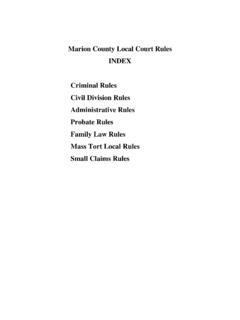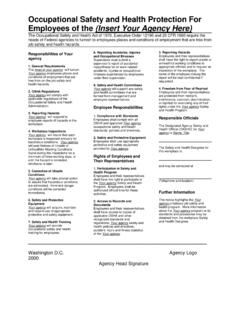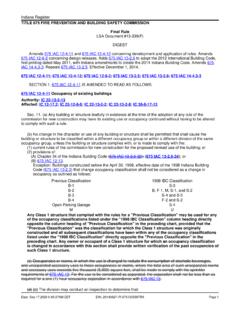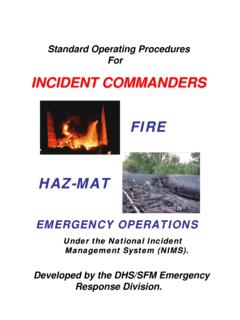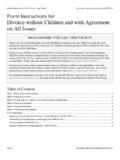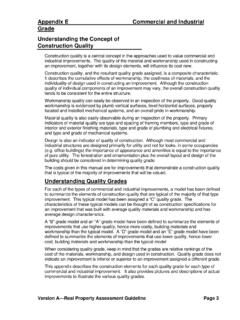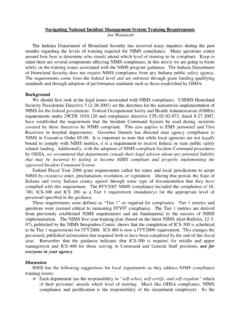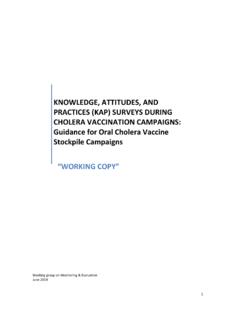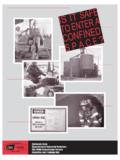Transcription of Section 501 Autopsy Protocol - IN.gov
1 140 Part 4 Records and Reports Section Case Files Regardless of whether you develop investigative protocols it is incumbent upon you to maintain as thorough and organized set of investigative files as possible. The investigative files should include but not be restricted to the following: all reports, investigator's notes, sketches and death scene photographs, reports of Autopsy and laboratory analyses of evidence, copies of all forms completed by the coroner to include chain-of-custody forms and laboratory request forms. The major objective is to maintain as complete and proper file as possible. Section 501. Autopsy Protocol Section 115. Section Ordering an 115. Section Autopsy 117. Section Overview Coroners may find the following definition of forensic pathology useful to their work. Forensic pathology is the branch of medical practice that produces evidence useful in the criminal justice administration, public health and public safety.
2 Under this definition are three key elements: Cause of Death, Manner of Death and Mechanism of Death. The cause of death related to the disease, injury or abnormality that alone or together in some combination initiates the physical and biological malfunctions that eventually leads to death. The cause of death can be thought of in terms of underlying or immediate cause of death. For example, a driver of an automobile dies in a single vehicle accident. The Autopsy discloses that the driver had a blood alcohol level of and the driver's heart had been pierced by a metal rod. The underlying cause of death would be penetrating trauma to the chest, the mechanism of death would be heart failure due to the penetrating metal rod, and acute alcohol intoxication would be listed as a contributing factor. The manner of death pertains to the way the death occurred. Social relationships and personal causation are two elements involved in determining manner of death.
3 Examples are the self-inflicted injuries of a suicide victim and the fatal injuries incurred as a result of an accidental fire in a home. The usual classifications of death are: natural, accident, suicide, homicide or undetermined. The mechanism of death refers to the process of death, in which failure of one or more vital organs due to injury, disease or natural events. For example, the mechanism of death for many diabetics is kidney failure. Other body organs, such as the liver, are adversely affected by kidney failure and death may follow. The actual cause of death may be due to heart or liver failure, but the diabetes was responsible for initiating the death process. Section 404 Investigator's Reports and Case Files Part 5 Autopsy Procedures 141. Caution: The pathologist will, or may, offer both a cause and manner of death in his/her report of the post- mortem.
4 However, the coroner is not bound by this report in determining manner of death. Often you will have additional information that was gathered at the death scene. This additional information and the results of the Autopsy will often allow you to reach a more accurate determination of the manner of death. Note: If there is a disagreement with the findings of the pathologist, the coroner and pathologist should strive to arrive at a consensual view. This is necessary, as such a disagreement could prove embarrassing to one or both parties, if it is brought out in court at a later date. Note: The mechanism of death should not be noted on the death certificate. (It is unnecessary and could create confusion or doubt in non-medical personnel.). Section Ordering an Autopsy An Autopsy is not required in every coroner's case; However, if in doubt, request an Autopsy be performed.
5 Normally, a decedent's body is the property of the next of kin (spouse, child, parent, brother or sister, nearest relative, guardian or executor of the estate). However, in deaths that are unusual, unnatural or suspicious in nature the state has an overriding interest which supersedes the interests of the family. The coroner has a responsibility to order an Autopsy on cases that are of interest to the state. Coroner's are protected from liability when ordering an Autopsy in good faith. In Indiana the person performing the Autopsy must be a pathologist certified by the American Board of Pathology in anatomic pathology, or a physician responsible to such a person. A coroner can not cut into or remove any part of a decedent's body under your jurisdiction, unless you meet the above stated qualifications. Exceptions to this is the aspiration (drawing or taking) of blood, urine, or other body fluid for chemical analysis if an Autopsy is considered unnecessary.
6 Caution: Do not take any fluids if an Autopsy is planned, as this will introduce artifacts; , puncture wounds on the body area from which you draw the fluids. An Autopsy is not required in every coroner's case. Whether or not to obtain an Autopsy is probably the hardest decision a coroner will have to make. Financial and family pressures often go against the coroner's desire for an Autopsy . The coroner should obtain an Autopsy , if required, despite these pressures. The coroner has the authority to order an Autopsy by Indiana Statute. (See Section , Coroner's Investigation of Death.) The county must provide the funds for post mortem examinations. Unnecessary autopsies also waste time and resources for everyone. Therefore, the coroner should carefully pick those cases requiring an Autopsy . Veteran coroners (and pathologists) have been known to make mistakes. However, the mistake is nearly always in not obtaining an Autopsy when needed.
7 If you are unsure in a particular case, you should call a colleague or a member of the Indiana State Coroners Training Board. Note: Family members, initially opposed to an Autopsy being performed, will normally be grateful later. (If they are not, be suspicious of them.). When the cause and manner of death cannot be established at the death scene an Autopsy is required. A. death case with an obvious cause and manner of death may require an Autopsy for legal documentation. In such cases, knowledge of specific mechanics of death are desired; ; determination of fatal wounds, contribution of any natural disease to the cause of death and the elapsed time between the moment of fatal injury and Section 501 Autopsy Protocol 142 Part 5 Autopsy Procedures physiological death. Generally, you will want to ask specific questions when ordering an Autopsy ; however, in some cases you may order an Autopsy based on heuristic (gut level) feelings.
8 In these latter cases, you may "feel" that something is not right after completing your investigation of the death scene. Every good investigator will follow his/her instincts on occasion. Thus, it is to your advantage to occasionally follow your own instincts or gut feelings about a particular case. If in doubt, request an Autopsy be performed. Determining If an Autopsy Is Required The Indiana State Coroners Training Board (ISCTB) has provided guidance to coroners in ordering autopsies. The ISCTB provided a list of questions to help coroners determine whether or not an Autopsy is necessary. If you can answer "Yes" to all the questions you do not need to order an Autopsy . You have sufficient evidence to sign off the case. If you answer "No" to more than two of the questions, then you definitely need an Autopsy . The questions are: 1. Has the possibility of homicide been eliminated?
9 2. Does external examination of the body give adequate evidence of the cause of death? 3. Have necessary toxicological specimens been obtained? 4. Is there no chance of civil litigation being filed? 5. Will the evidence of suicidal intent stand up in court? 6. Is the decedent well known in the area? 7. Was the event witnessed by more than one person? 8. Was there documented evidence of disease if an apparent natural death 9. Have the next of kin accepted the death? Are they likely to harbor guilt feelings? 10. Did symptoms precede the death if an apparent natural death? 11. Was the deceased not in a motor vehicle? 12. Was the deceased not in the workplace? 13. Has the body been positively identified? Cases That Always Require an Autopsy There are some cases that always require an Autopsy . The ISCTB has provided the following list of circumstances that require an Autopsy : 1.
10 Fire deaths, when the body is altered by fire or the carbon monoxide saturation is below 20%. 2. Homicides or any cases in which another person is in anyway a possible factor in the death. 3. Apparent suicides that are without clear evidence of intent, such as those without a note. 4. Drivers in single car accidents. 5. Pilots involved in aircraft crashes. 6. Occupation related deaths. 7. Unwitnessed "accidents.". 8. Accidents in which natural disease cannot be ruled out as a factor. 9. Cases where civil litigation may evolve. 10. Deaths of persons in official custody. 11. Sudden, unexpected deaths of children, especially if they are under two years of age. Autopsy Determinations The importance of autopsies can be illustrated by knowing what information may be obtained through this procedure. The ISCTB has listed a number of things that may be determined from an Autopsy .



